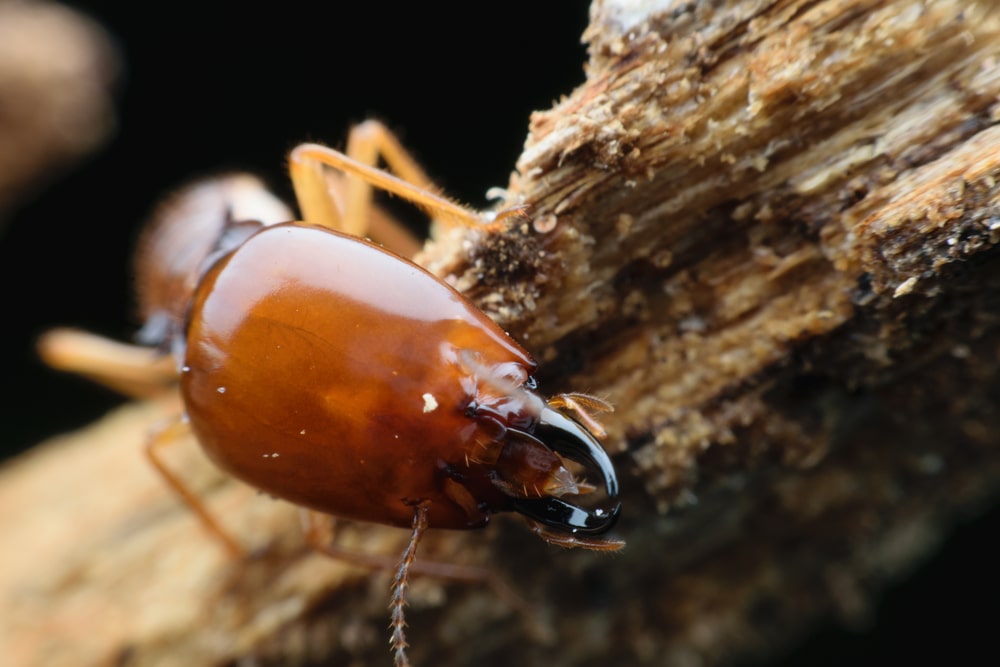Contributed by: Doug Webb
Updated on: January 24, 2023
What are dampwood termites?
Dampwood termites, as their name suggests, are commonly found in moist or rotting wood. They are typically larger than drywood or subterranean termites, ranging in size between one-half to nearly one-inch in length.
Like other termites, they consume the cellulose found in wood. However, dead or rotting wood – or even gutters clogged with damp, rotting leaves – can provide a particularly hospitable environment with an ample moisture supply that's required for these pests to thrive.
Dampwood termite identification
- Size: When it comes to sheer size, dampwood termites are the largest termites in North America. In contrast, their colony sizes are among the smallest. Kings and queens measure between one-half to five-eighths of an inch in length. Nymphs can also grow to be five-eighths of an inch long, while soldiers can grow up to three-fourths of an inch in length.
- Color: Dampwood termites are generally brown in color, but can range from dark to light, and can even be reddish, especially towards their abdomens. Nymphs are cream-colored.
- Wings: When it's time for dampwood termites to swarm, their wings can be an identifying marker. Dampwood termites have two front wings and two rear wings, all of which are equal in size and shape.
- Legs: All dampwood termites have six legs.
- Body: Dampwood termites have three body segments: a smaller head segment, and a larger segment that contains their thorax and abdomen.
- Antennae: Dampwood termites have two straight antennae protruding from their head segment.
Dampwood termite habits and behavior
Dampwood termites need regular contact with water and high humidity to survive. This makes them very different from their drywood cousins.
Dampwood termites do not create shelter tubes, as subterranean termites do, and can live completely within the wood that they are eating. These termites plug openings into the wood they are infesting with fecal pellets (or “frass") to preserve humidity levels. Their cryptic behavior can keep them from being discovered for years.
Dampwood termites usually infest felled timber, dead trees and stumps and feast on the contents. Specialized organisms within their intestines help them digest wood.

Dampwood termite habitats
Dampwood termites typically infest damp and decaying timber, as their name implies. Therefore, they are found mostly in damper places like in Western states, such as:
- California
- Idaho
- Montana
- Nevada
- Oregon
- Washington
Other less-damaging species are found in the Southwest area of the United States and in Florida.
Dampwood termites can infest structures where high moisture levels exist from plumbing leaks, ventilation deficiencies or from drainage problems. Old gutters filled with leaves can also cause excessive moisture to accumulate in wall cavities, creating an attractive environment for these humidity-loving insects.
Dampwood termite signs
Dampwood termites are typically found infesting decayed wood or in areas with a lot of moisture. These termites need water and humid conditions to survive. With this in mind, there are a few signs to look for that may indicate a dampwood termite infestation:
- Wood that sounds hollow when tapped.
- Wood that feels soft or squishy to the touch.
- An absence of frass pushed outside of holes. While most termites will push their waste out of holes they have chewed in wood, dampwood termites will use their droppings to seal up any openings in wood to lock in moisture and humidity.
Tips for dampwood termite prevention
In order to prevent or control a dampwood termite infestation in your home:
- Your first priority should be to address moisture issues. When the colony's source of water is removed, most will not survive.
- Control can also be achieved by making structural changes, such as replacing damp, infested wood.
Dampwood termite treatment
Although Terminix termite control professionals do not usually treat for dampwood termites, you can help reduce the likelihood of an infestation. By removing sources of moisture, you can help prevent dampwood termites around your home.
For any other termite treatment services or questions, please don't hesitate to schedule a free termite inspection, and one of our termite control professionals will be glad to assist you.



